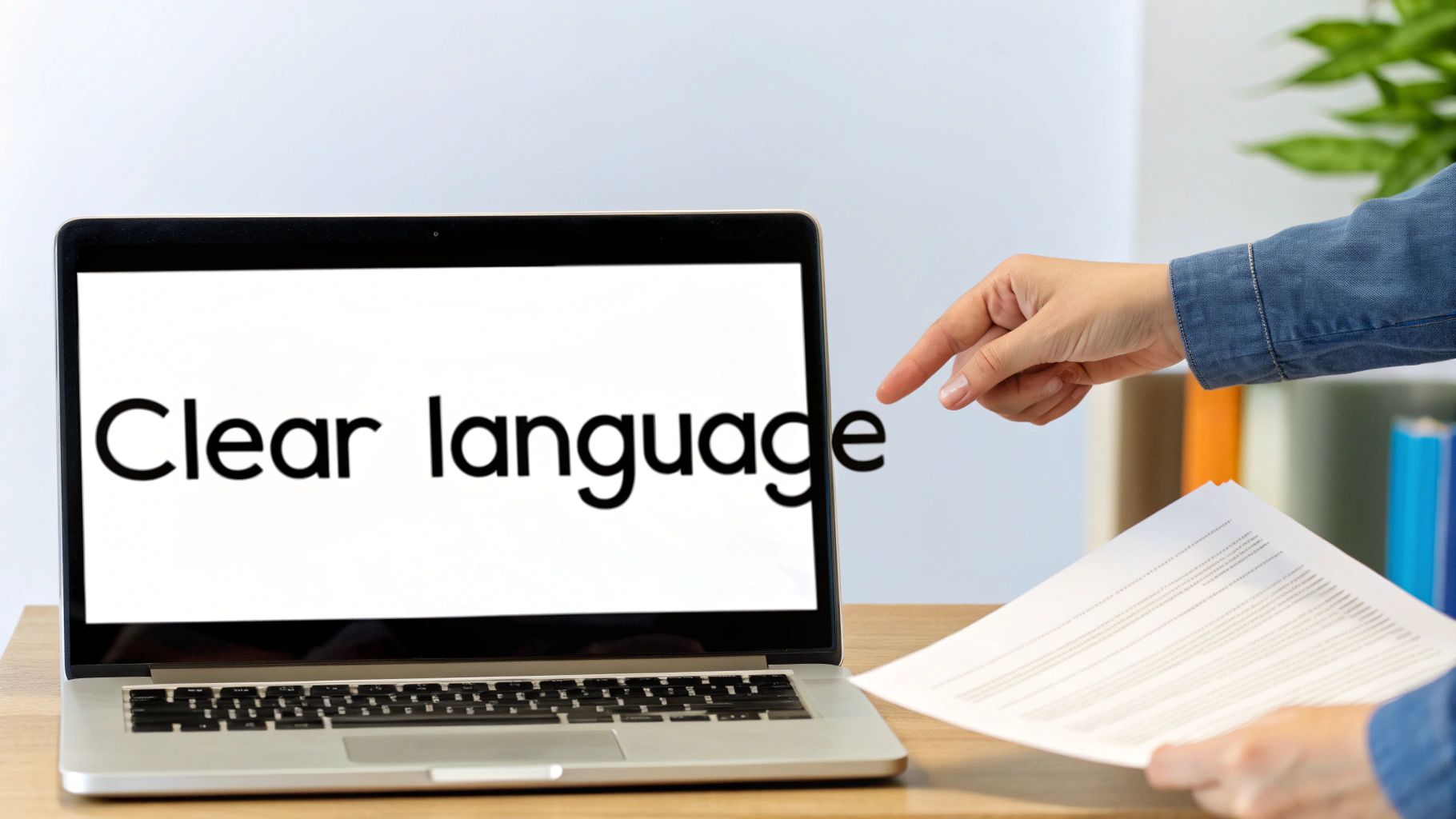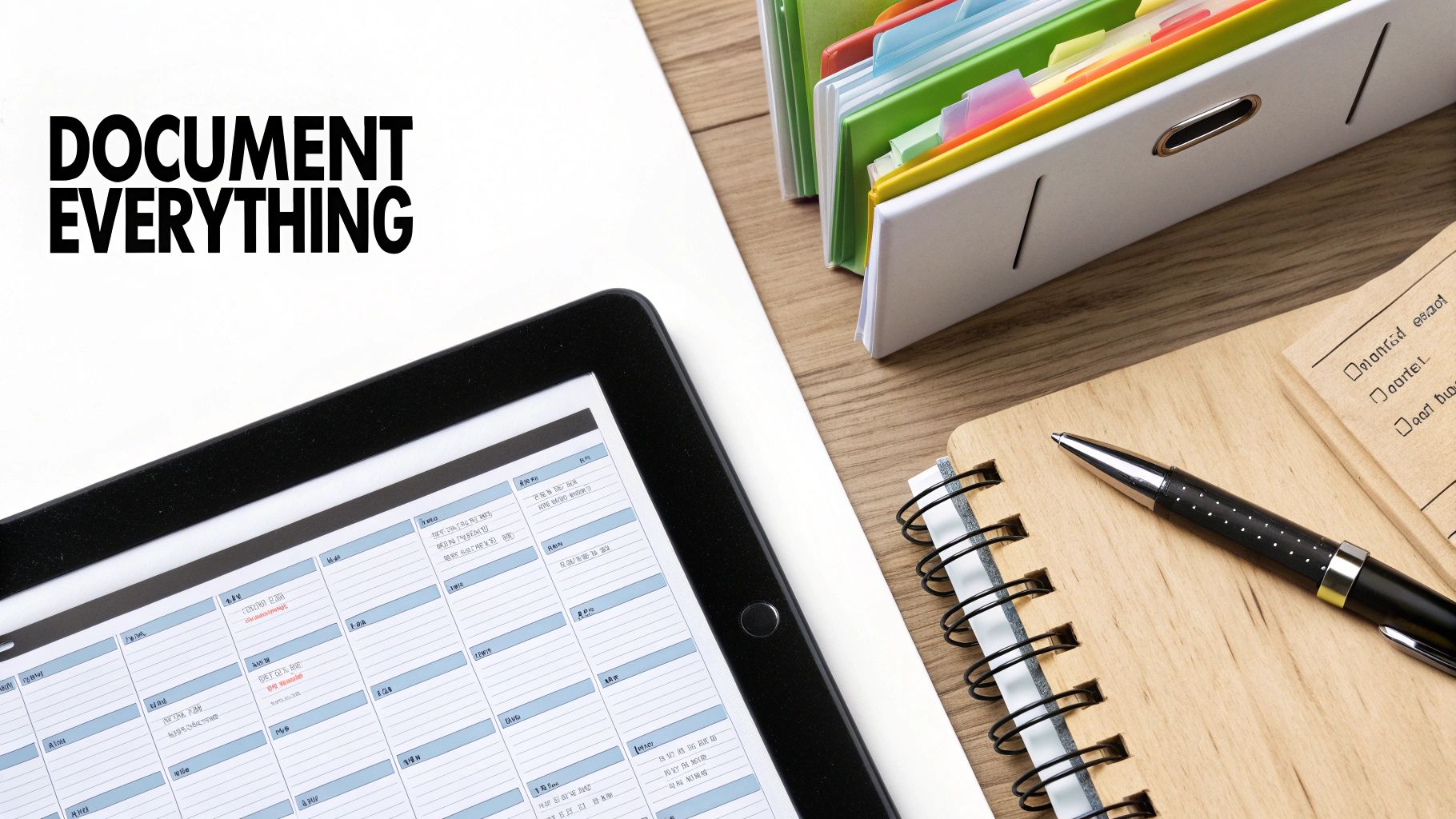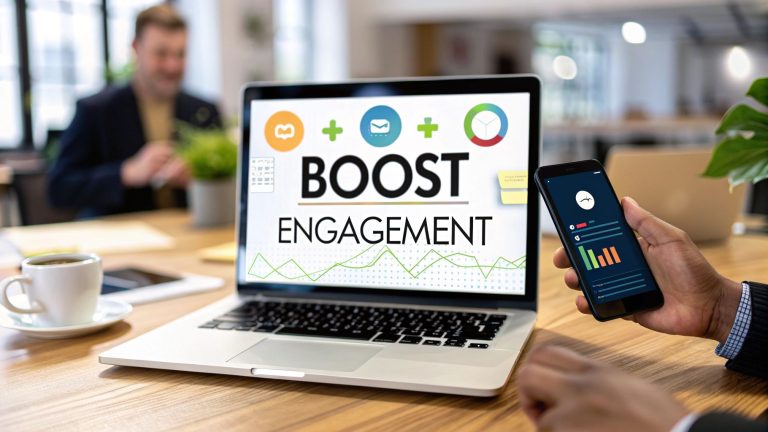client communication best practices: Quick guide to trust
In a competitive market, what separates a good service from a great one often comes down to a single, critical skill: communication. It is the invisible architecture of every successful client relationship, influencing everything from project outcomes to long-term loyalty. Yet, effective client interaction is more than just quick replies and polite emails; it is a strategic system built on proven client communication best practices designed to foster trust, align expectations, and create genuine partnerships.
Mastering this skill means the difference between a one-time project and a lasting, profitable relationship. Poor communication leads to scope creep, missed deadlines, and client churn. Exceptional communication, however, builds a foundation of confidence that makes clients feel heard, valued, and understood. It transforms a simple service transaction into a collaborative success story, directly impacting retention and referrals.
This guide dives deep into 10 essential client communication best practices that go beyond the obvious. We will move past generic advice and provide specific, actionable frameworks your team can implement immediately. From the art of active listening and empathetic responses to the non-negotiable importance of documenting every interaction, these strategies will equip your team to not just manage clients, but to truly connect with them. Get ready to explore the practical techniques that turn routine conversations into powerful tools for client satisfaction and business growth.
1. Active Listening and Empathetic Response
Effective client communication best practices begin not with speaking, but with listening. Active listening is the practice of fully concentrating on a client's message, comprehending their emotional context and underlying concerns, and responding thoughtfully. It’s a foundational skill that transforms interactions from transactional exchanges into meaningful conversations, making clients feel genuinely heard and valued.
This approach goes beyond simply hearing words; it involves interpreting non-verbal cues, asking clarifying questions, and confirming your understanding. As Stephen Covey famously advised, "Seek first to understand, then to be understood." This principle is the cornerstone of building trust and demonstrating that you are a partner invested in the client's success, not just a service provider.

Why It Works: Real-World Impact
Adopting active listening generates tangible business results. For instance, Zappos empowers its customer service team to listen without time constraints, a strategy that has built legendary customer loyalty. Similarly, Salesforce implemented active listening training for its customer success teams and saw a 35% increase in customer satisfaction scores. These examples show that investing in listening skills directly impacts client retention and satisfaction.
How to Implement Active Listening
Integrating this practice requires conscious effort and a few structural changes.
- Paraphrase and Summarize: Before responding, repeat back what you've heard using phrases like, "So, if I'm understanding correctly, the main issue is…" This confirms you've grasped the core problem and gives the client a chance to correct any misunderstandings.
- Ask Open-Ended Questions: Instead of questions that yield a simple "yes" or "no," ask questions that encourage detailed responses. For example, "Can you walk me through the challenges you're facing with the current system?" prompts a more insightful answer than "Is the system not working?"
- Avoid Interrupting: Make a conscious effort to let the client finish their thoughts completely before you formulate or voice your response. Take notes on key points to address once they are done speaking.
- Acknowledge Emotions: Empathetically respond to the client's feelings. A simple statement like, "I can see why that would be a frustrating experience," validates their perspective and builds a stronger connection.
2. Set Clear Expectations from the Start
Ambiguity is the enemy of successful client relationships. Setting clear, documented expectations at the beginning of any project is a cornerstone of effective client communication best practices. This proactive step defines scope, timelines, deliverables, communication protocols, and success metrics, creating a shared understanding that prevents confusion, scope creep, and disappointment down the line.
This practice transforms the client engagement from a guessing game into a well-defined partnership. It establishes a single source of truth that both parties can refer to, ensuring alignment from kickoff to completion. By clearly articulating the "what, when, how, and why" of a project upfront, you build a foundation of trust and transparency that minimizes friction and maximizes results.
Why It Works: Real-World Impact
Proactive expectation setting directly correlates with project success and client satisfaction. For example, the project management software company Basecamp provides new clients with a detailed 'Getting Started Guide' that outlines project management processes and communication cadences, drastically reducing onboarding questions. Similarly, design firm IDEO uses comprehensive project briefs and kickoff meetings to align on creative vision and practical constraints, ensuring a smooth collaborative process. These examples demonstrate that a small investment in initial alignment pays significant dividends throughout the engagement.
How to Implement Clear Expectation Setting
Integrating this practice requires a structured approach to your client onboarding process.
- Create an Onboarding Document: Develop a standard template that outlines all key project parameters. This document should be a central part of your process. For a comprehensive guide, explore this client onboarding checklist on leadsavvy.pro.
- Schedule a Dedicated Kickoff Meeting: Use a formal meeting to walk the client through the project plan, scope, and communication protocols. This allows for real-time clarification and confirms mutual understanding.
- Document Everything in Writing: Follow up verbal agreements with a written summary via email or in your project management tool. This creates an official record and avoids "he said, she said" scenarios.
- Set Buffer Time: Build contingency time into your timelines for unexpected delays or revisions. Being transparent about this buffer manages expectations realistically from the start.
- Review at Project Milestones: Revisit and reconfirm expectations at key stages of the project. This ensures the project stays on track and addresses any shifts in priorities.
3. Maintain Regular and Proactive Communication
One of the most impactful client communication best practices is shifting from a reactive to a proactive stance. Proactive communication involves anticipating client needs and providing updates, progress reports, and relevant information before they even think to ask. This approach keeps clients informed, minimizes anxiety, and demonstrates that you are in full control of the project or service.
Instead of waiting for a client to inquire about progress, you establish a consistent rhythm of updates that builds confidence and reinforces the value you provide. As advocated by Marcus Sheridan’s "They Ask, You Answer" philosophy, addressing potential questions and concerns preemptively positions you as a transparent and trustworthy partner, solidifying the client relationship and preventing small uncertainties from escalating into major issues.
Why It Works: Real-World Impact
Proactive communication directly translates to higher client satisfaction and retention. For instance, Amazon Web Services (AWS) sends proactive notifications about system maintenance and potential service disruptions, giving customers time to prepare and building immense trust in their reliability. Similarly, HubSpot’s customer success team leverages automated weekly reports to show clients platform usage and progress toward their goals, a tactic that has resulted in a 20% improvement in client engagement metrics.
How to Implement Proactive Communication
Making this shift requires a deliberate strategy and the right tools.
- Establish a Communication Calendar: At the start of a project, agree on a schedule for regular updates (e.g., a weekly email, a bi-weekly call). This sets clear expectations from day one.
- Send Updates, Even With No News: A quick message like, "No major updates this week, but we are on track with the planned tasks for next Tuesday," is far better than silence. It reassures the client that you haven't forgotten them.
- Use Client-Facing Tools: Implement project management software with a client dashboard, like Asana or Trello, to provide real-time visibility into progress without needing a formal meeting.
- Report Bad News Early: If a problem arises, notify the client immediately. Informing them of a challenge along with a proposed solution demonstrates accountability and prevents them from being blindsided later.
- Automate Routine Updates: Use CRM or email marketing tools to automate simple check-ins or status reports, freeing up your team to focus on more strategic communication.
4. Choose the Right Communication Channel
Different messages require different mediums. Strategically selecting the right communication channel is one of the most impactful client communication best practices. This involves choosing the appropriate medium based on the message's urgency, complexity, formality, and the client's own preferences. A quick question might suit instant messaging, while a complex strategy discussion demands a video call.
This intentional approach prevents communication mismatches, like sending an urgent, complex issue via an email that gets buried, or interrupting a client's deep work with a phone call for a non-urgent update. As Slack founder Stewart Butterfield demonstrated, creating dedicated channels for specific types of conversations streamlines workflow and reduces noise. Applying this principle to client interactions ensures your message is received and processed effectively, respecting both your time and the client's.
Why It Works: Real-World Impact
Matching the channel to the message enhances clarity and efficiency. For example, marketing agency Wieden+Kennedy implements a clear protocol: Slack for quick daily questions, email for formal project updates, and video conferences for creative reviews. This prevents context-switching and ensures everyone knows where to find specific information. Similarly, financial advisors at Vanguard often use video calls for comprehensive quarterly reviews to build rapport, but revert to secure email for routine account updates and documentation. This structured approach has been shown to reduce client misunderstandings by over 40% in some professional service firms.
How to Implement Channel Selection
Building a channel strategy is straightforward and highly effective.
- Create a Communication Matrix: During client onboarding, collaboratively create a simple chart defining which channel to use for different scenarios (e.g., urgent issues, project approvals, quick questions).
- Use Email for Documentation: Reserve email for formal communications, approvals, and anything that requires a clear paper trail. It's the ideal medium for non-urgent, detailed information.
- Reserve Calls for Complexity: Use phone or video calls for sensitive, nuanced, or complex topics where tone and immediate feedback are crucial for clear understanding.
- Follow Up Verbal Chats: Always send a brief written summary via email after an important call. This confirms understanding, documents key decisions, and outlines next steps.
- Set Channel Boundaries: Clearly define response time expectations for each channel and respect client preferences regarding after-hours or weekend communications, particularly on instant messaging platforms.
5. Respond Promptly and Set Response Time Expectations
In a fast-paced digital world, the speed of your response is often interpreted as a direct measure of your competence and respect for the client. Promptly addressing inquiries and setting clear expectations for response times are crucial client communication best practices that build trust and maintain project momentum. This practice is not about being available 24/7; it's about establishing transparent, reliable communication protocols that show clients they are a priority.
This approach demonstrates that you value your client's time and are organized enough to manage communications effectively. By defining and adhering to a response timeline, you prevent client anxiety, reduce follow-up emails, and create a predictable, professional working relationship. As exemplified by Amazon's customer-centric culture, responsiveness is a cornerstone of client satisfaction and a powerful differentiator in a competitive market.
Why It Works: Real-World Impact
Setting and meeting response expectations has a measurable impact on client perception and retention. For instance, Shopify Plus guarantees a response within one hour for its priority customers, a clear value proposition that justifies its premium service. Similarly, the global law firm White & Case commits to acknowledging all client emails within four business hours, assuring clients that their messages have been received and are being handled. These standards eliminate uncertainty and solidify the client's confidence in the service provider.
How to Implement Prompt Responses
Integrating this practice requires a clear strategy and consistent team-wide execution.
- Establish and Communicate Your Policy: Define a specific response time commitment (e.g., "We will respond to all inquiries within 24 business hours") and include it in your email signature, project kickoff materials, and client agreements.
- Use Acknowledgment Replies: If you can't provide a full answer immediately, send a quick reply to acknowledge receipt. A simple, "Thanks for your message. I'm looking into this and will get back to you with a detailed response by the end of the day," manages expectations perfectly.
- Leverage Templates and Automation: Use templates for common inquiries to speed up your initial response. Auto-responders can also be effective for immediately acknowledging contact form submissions or after-hours messages.
- Prioritize Urgent Matters: Create an internal system to triage incoming communications based on urgency and importance. This ensures that critical issues receive the fastest attention without disrupting your overall workflow. You can learn more about effective follow-up strategies in our guide to lead follow-up best practices.
6. Use Clear, Jargon-Free Language
Effective client communication hinges on mutual understanding, and nothing creates a barrier faster than confusing language. Using clear, jargon-free language means prioritizing comprehension over complexity. It involves deliberately avoiding industry-specific acronyms, technical terms, and convoluted phrasing that might alienate or confuse a client who lacks your specialized expertise. The objective is to make information accessible, not to showcase your vocabulary.
This practice transforms communication from a one-way display of knowledge into a two-way dialogue, fostering trust and ensuring everyone is aligned. When clients can easily grasp complex ideas, they feel more confident in your partnership and the decisions being made. It respects their time and intelligence by delivering information in the most direct and digestible way possible.

Why It Works: Real-World Impact
Clarity directly translates to better client outcomes and stronger relationships. For instance, Stripe’s API documentation is celebrated for its ability to explain complex payment processing in simple, developer-friendly terms, reducing implementation friction. Similarly, Mailchimp’s interface uses conversational language like "Send Campaign" instead of "Deploy Email Marketing Initiative," making their platform intuitive and user-friendly. These examples demonstrate that simplifying language is one of the most effective client communication best practices for building confidence and reducing errors.
How to Implement Clear Language
Adopting this practice requires a conscious shift in how you frame information for your audience.
- Adopt the "Grandmother Test": Before sending a message, ask yourself, "Would my grandmother understand this?" This simple filter, popularized by plain language expert Ann Wylie, helps you quickly identify and eliminate unnecessary jargon.
- Define Necessary Terms: If a technical term is unavoidable, define it clearly the first time it is used. For example, "We'll be tracking KPIs, which are Key Performance Indicators used to measure success…"
- Use Analogies and Examples: Explain complex concepts by relating them to familiar ideas. Describing a server as "a powerful computer that stores your website's files" is more effective than discussing server architecture.
- Seek External Review: Have a colleague from another department read your client-facing communications. If they are confused by any part of it, it's a clear sign that you need to simplify your language further.
7. Document Everything and Maintain Communication Records
Systematic documentation of all client interactions, decisions, and agreements is a cornerstone of professional client communication best practices. It creates a reliable reference system that protects both parties, ensures project continuity, and eliminates "he said, she said" disputes. This practice involves diligently recording meeting notes, email confirmations, change requests, and key decisions to build a comprehensive communication history that serves as a single source of truth.
This methodical approach transforms communication from a series of fleeting conversations into a structured, auditable record. By maintaining clear documentation, you establish a transparent framework for accountability and clarity. This not only mitigates risk but also reinforces trust, as clients see a clear, organized process behind every action and decision.

Why It Works: Real-World Impact
Implementing rigorous documentation protocols delivers significant operational benefits. For instance, global architecture firm Gensler maintains comprehensive project documentation, including all client feedback and decision points, which is crucial for managing complex, multi-million dollar projects without costly misinterpretations. Similarly, IBM requires consultants to log detailed interaction notes in their CRM within 24 hours, ensuring team-wide alignment and a seamless client experience, even when personnel changes occur.
How to Implement Documentation
Integrating this practice requires discipline and the right tools.
- Send Timely Summaries: After any significant meeting or call, send a concise summary email outlining key discussion points, decisions made, and next steps. Do this within 24 hours while the details are still fresh for everyone.
- Use a Centralized System: Implement a tool like a project management system or a CRM where all team members can access and contribute to client records. This prevents information silos and ensures consistency. For a deeper dive into this, you can learn more about how a CRM for an agency can streamline this process.
- Get Written Confirmations: For any critical decision, scope change, or approval, always request confirmation in writing. An email reply is often sufficient to create a formal record.
- Standardize with Templates: Create consistent templates for meeting notes, change requests, and project updates. This makes documentation faster and ensures all necessary information is captured every time.
8. Practice Transparency and Honesty, Especially with Bad News
Transparent communication, especially when delivering unfavorable news, builds trust and credibility far more effectively than any amount of good news. This practice involves honestly communicating challenges, setbacks, mistakes, and limitations while proactively presenting solutions and taking responsibility. It is a cornerstone of professional integrity and long-term client partnerships.
This approach requires resisting the urge to sugarcoat or delay difficult conversations. Instead, it means sharing information proactively, admitting when you don't know something, and never misleading clients for short-term comfort. As famously advocated by leaders like Warren Buffett and Kim Scott, this radical candor transforms client relationships from transactional to deeply loyal.
Why It Works: Real-World Impact
Honesty during a crisis can cement a client relationship for life. For example, when AWS experiences an outage, they provide detailed and transparent post-mortem reports explaining what went wrong and what steps are being taken to prevent recurrence. This builds immense trust. Similarly, Buffer’s radical transparency policy, where they publicly share revenue and internal challenges on their blog, has created an incredibly loyal community that champions their brand.
How to Implement Transparency
Being honest with bad news is a skill that can be developed with a clear framework.
- Deliver Bad News Promptly: Never delay hoping the problem will resolve itself. Address issues as soon as you are aware of them to give the client maximum time to adjust.
- Use the 'Situation-Impact-Action' Framework: Clearly state the situation ("The feature update caused a server error"), explain the impact ("This means your dashboard is currently unavailable"), and detail the action ("Our engineering team is deploying a fix now and we expect it to be resolved within the hour").
- Present Problems with Solutions: Don't just report a problem; arrive with a proposed solution or a clear plan to find one. This shows you are in control and focused on resolution.
- Take Ownership Without Excuses: Acknowledge your role in the issue with phrases like, "We made a mistake in the deployment process." Avoid blaming others, as this erodes credibility and is a poor client communication best practice.
9. Personalize Communication and Remember Client Details
Effective client communication best practices go beyond professional courtesy; they build genuine human connections. Personalization is the practice of treating clients as valued individuals, not just account numbers. This means remembering personal details, preferences, past conversations, and unique circumstances to tailor your interactions and show you care about them beyond the transaction.
This approach transforms your relationship from a simple service exchange into a trusted partnership. As Dale Carnegie articulated in How to Win Friends and Influence People, a person's name is the sweetest sound in any language. Remembering and using these details demonstrates genuine interest and respect, fostering a level of loyalty that generic, templated communication can never achieve.
Why It Works: Real-World Impact
Personalization directly impacts client loyalty and retention. The Ritz-Carlton hotel group built its legendary reputation on this principle, using a detailed client database to track guest preferences, from pillow types to favorite beverages, ensuring a bespoke experience at any property worldwide. Similarly, top financial advisors at Charles Schwab maintain detailed client profiles, noting family birthdays and career milestones, which strengthens client trust and leads to higher asset retention.
How to Implement Personalization
Integrating this practice requires a system for capturing and using client information.
- Take Detailed Notes: After every client interaction, jot down key personal and professional details discussed. Use custom fields in your CRM to track hobbies, family details, or career goals.
- Reference Previous Conversations: Start follow-up emails or calls by mentioning a point from your last discussion. For example, "Last time we spoke, you mentioned your daughter's graduation. I hope it was a wonderful celebration!"
- Acknowledge Milestones: Set calendar reminders for client birthdays, business anniversaries, or other important dates. A simple congratulatory email or a handwritten card for a major award can have a huge impact.
- Adapt Your Communication Style: Pay attention to your client's energy and preferences. If a client is direct and data-driven, keep your communication concise and factual. If they are more relational, take time for small talk.
10. Solicit, Accept, and Act on Client Feedback
Excellent client communication best practices extend beyond project delivery to creating a continuous feedback loop. This involves actively seeking client input, welcoming it without defensiveness, and demonstrably acting upon it. This approach transforms relationships from transactional to collaborative, making clients feel like valued partners whose insights directly shape the service they receive.
A feedback loop is not a one-time survey; it's an ongoing process. As Amazon’s customer-obsessed culture illustrates, treating client feedback as a critical business intelligence tool is fundamental to growth. By systematically collecting, analyzing, and implementing client suggestions, you signal that their voice matters, fostering deep-seated loyalty and preventing minor issues from becoming major problems.
Why It Works: Real-World Impact
Creating a formal system for feedback yields significant returns. For instance, Airbnb's two-way review system not only builds trust between hosts and guests but also provides a constant stream of data to improve its platform and policies. Similarly, Microsoft's UserVoice platform allows customers to suggest and vote on new product features, providing a clear roadmap for development that aligns with user needs and resulted in a 40% increase in feature adoption for some products.
How to Implement a Feedback Loop
Building an effective feedback process requires a structured and genuine approach.
- Ask Specific Questions: Instead of a generic "How are we doing?", ask targeted questions like, "What is one thing we could do to make our weekly reports more valuable for you?" This elicits more actionable responses.
- Use Multiple Channels: Offer various ways for clients to provide input, including scheduled feedback calls, anonymous surveys using tools like SurveyMonkey, and informal check-ins. This caters to different communication preferences.
- Close the Loop Publicly: Acknowledge all feedback received. More importantly, communicate the changes made as a result. Send an email saying, "Based on your feedback about project timelines, we have now integrated a shared calendar to improve transparency."
- Track Feedback Trends: Use a simple spreadsheet or CRM to log feedback across all clients. This helps you identify systemic issues or recurring suggestions that point to opportunities for broader service improvements.
Top 10 Client Communication Practices Comparison
| Practice | 🔄 Implementation Complexity | ⚡ Resource Requirements | 📊 Expected Outcomes (⭐) | 💡 Ideal Use Cases | ⭐ Key Advantages |
|---|---|---|---|---|---|
| Active Listening and Empathetic Response | Medium — training + sustained attention | Low–Medium — time per meeting, training | Stronger trust, fewer misunderstandings (⭐⭐⭐⭐) | Client discovery, conflict resolution, high‑stakes meetings | Builds deep rapport; uncovers hidden needs |
| Set Clear Expectations from the Start | Medium — upfront documentation & alignment | Medium — templates, legal/PM input | Fewer scope issues, clearer accountability (⭐⭐⭐⭐) | New projects, contracts, multi‑team engagements | Prevents scope creep; sets accountability |
| Maintain Regular and Proactive Communication | Medium — establish cadence & processes | Medium — automation, reporting tools, team time | Increased transparency; earlier issue detection (⭐⭐⭐⭐) | Long projects, stakeholder updates, operational work | Keeps stakeholders engaged; prevents surprises |
| Choose the Right Communication Channel | Low–Medium — policy + onboarding | Low — channel setup, documentation | Better comprehension & response rates (⭐⭐⭐) | Multi‑stakeholder, mixed tech comfort, urgent vs complex messages | Matches message to medium; reduces friction |
| Respond Promptly and Set Response Time Expectations | Low — define SLAs and protocols | Medium — monitoring, auto‑responders, staffing | Reduced client anxiety; perceived reliability (⭐⭐⭐⭐) | Support services, priority clients, time‑sensitive work | Demonstrates reliability; competitive edge |
| Use Clear, Jargon‑Free Language | Low — style guide and review habits | Low — editing time, training | Faster decisions; fewer misunderstandings (⭐⭐⭐⭐) | Technical → nontechnical communications, onboarding | Improves comprehension; inclusive communication |
| Document Everything and Maintain Communication Records | High — consistent discipline, processes | High — CRM/PM systems, storage, admin time | Accountability, continuity, legal protection (⭐⭐⭐⭐) | Regulated industries, long engagements, handoffs | Enables dispute resolution; preserves history |
| Practice Transparency and Honesty, Especially with Bad News | Medium — cultural alignment & coaching | Low–Medium — prep time, leadership buy‑in | Deepens long‑term trust; better collaboration (⭐⭐⭐⭐) | Crisis communication, strategic advising, escalations | Builds credibility; fosters collaborative fixes |
| Personalize Communication and Remember Client Details | Medium — CRM use + habit formation | Medium — CRM, time to record & personalize | Higher loyalty, referrals, retention (⭐⭐⭐⭐) | High‑value accounts, relationship management | Emotional connection; differentiates service |
| Solicit, Accept, and Act on Client Feedback | Medium — feedback loops & analysis | Medium — survey tools, analysis, follow‑up | Continuous improvement; higher retention (⭐⭐⭐⭐) | Product/service improvement, retention programs | Actionable insights; client engagement in changes |
Putting It All Together: From Principles to Practice
Navigating the landscape of client relationships can feel complex, but the journey from good to great is paved with intention and consistency. We've explored ten foundational client communication best practices, from the empathetic power of active listening to the structural necessity of documenting everything. Each principle, whether it’s setting clear expectations from day one or delivering bad news with transparency, serves as a crucial building block for creating durable, trust-based partnerships.
However, understanding these concepts is only the first step. The real transformation occurs when these principles are woven into the daily fabric of your operations, moving from abstract ideals to concrete, team-wide habits. This isn't about a complete, overnight overhaul. It's about strategic, incremental improvement.
From Knowledge to Action: Your Implementation Roadmap
True mastery of client communication doesn't come from a checklist but from building a sustainable system. The key is to start small and build momentum. Don't try to implement all ten practices at once; you'll risk overwhelming your team and achieving nothing. Instead, adopt a phased approach.
Step 1: Diagnose and Prioritize
Begin with a candid assessment of your current communication protocols. Where are the most significant friction points?
- Are clients frequently confused about project timelines? Focus on Setting Clear Expectations (Practice #2).
- Do you find yourself reacting to problems instead of preventing them? Prioritize Regular and Proactive Communication (Practice #3).
- Is negative feedback a recurring theme? It might be time to overhaul how you Solicit, Accept, and Act on Client Feedback (Practice #10).
Choose one or two high-impact areas to tackle first. This focused effort ensures that new habits are properly embedded before you introduce the next set of improvements.
Step 2: Systematize and Empower with Technology
Once you've identified your starting point, create systems to support the new behavior. For instance, if prompt responses are your goal, a simple process change can make a world of difference. This is where technology becomes a powerful enabler, not just a tool.
A cornerstone of excellent service, especially for marketing and sales teams, is rapid lead follow-up. This is your very first communication with a potential client, and it sets the tone for everything that follows. Manually transferring lead data from platforms like Facebook Lead Ads is slow, error-prone, and a direct barrier to Prompt Communication (Practice #5).
By automating the tedious but critical task of lead data entry, you free up your team to do what humans do best: build relationships, understand needs, and have meaningful conversations. Automation doesn't replace personalized communication; it creates the time and space for it.
This is a prime example of how integrating a tool can directly support a core communication principle. Instead of spending 15 minutes copying and pasting a new lead's information, your team can spend that time crafting a personalized welcome email or making an introductory call, demonstrating efficiency and attentiveness from the very first interaction.
The Lasting Impact of Exceptional Communication
Ultimately, elevating your client communication best practices is an investment that pays dividends far beyond individual project success. It builds a reputation for reliability and partnership, turning satisfied clients into vocal advocates for your brand. This commitment to clarity, transparency, and responsiveness becomes a powerful competitive differentiator in a crowded marketplace.
It’s an ongoing journey of refinement, not a final destination. By consistently applying these principles, you're not just managing accounts; you're building a resilient business foundation rooted in strong, mutually beneficial relationships.
Ready to eliminate delays and make a powerful first impression? LeadSavvy Pro instantly syncs your Facebook leads with your CRM or Google Sheets, empowering your team to respond in minutes, not hours. See how seamless automation can transform your client communication by visiting LeadSavvy Pro today.







